
Understanding sewing machine parts and their functions is essential for effective sewing. This guide provides a detailed overview of components, from basic to advanced, ensuring optimal machine operation and troubleshooting.
Learning about parts like the spool pin, tension disc, and presser foot enhances sewing skills. Regular maintenance, such as lubrication and cleaning, prolongs machine life and performance.
Whether you’re a beginner or an experienced sewer, this section offers insights into mastering your sewing machine, helping you achieve professional results in your projects.
Downloadable PDF resources are available, offering labeled diagrams and comprehensive explanations of sewing machine parts and their functions, perfect for quick reference and learning.
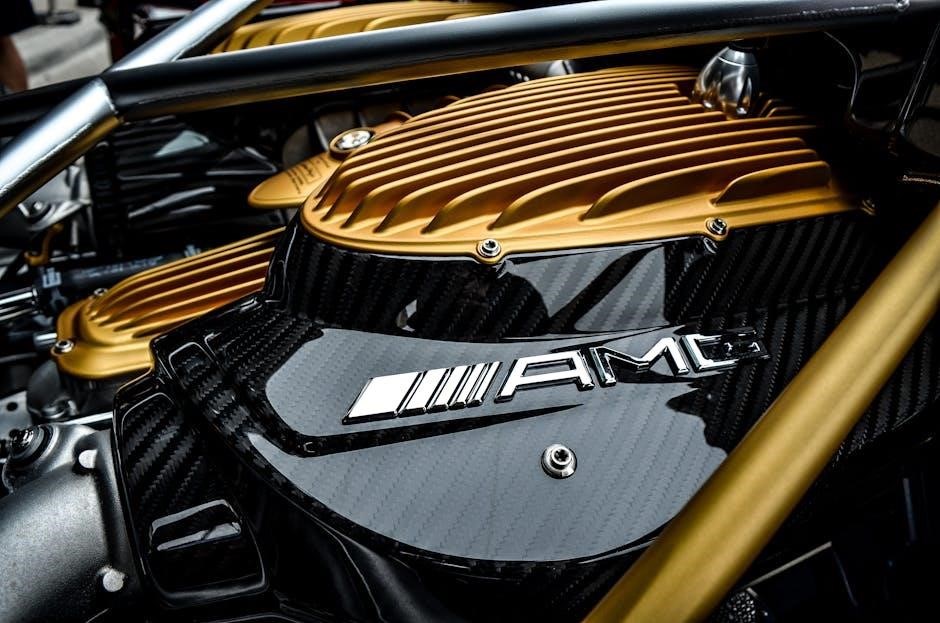
1.1 Overview of Sewing Machine Components
A sewing machine consists of several key components that work together to perform sewing tasks efficiently. The basic parts include the spool pin, which holds the thread, and the thread guide, which directs the thread through the machine. The bobbin provides the bottom thread, while the needle and needle bar create the stitches. The presser foot holds the fabric in place, and the feed dogs move the fabric forward. Additional components like the tension disc and take-up lever regulate thread tension, ensuring even stitching. Understanding these components is crucial for proper machine operation and troubleshooting common issues. Modern machines may also feature advanced parts like automatic thread cutters and programmable stitch patterns.
1.2 Importance of Understanding Sewing Machine Parts
Understanding sewing machine parts is vital for effective operation and maintenance. Knowing each component’s function enables precise troubleshooting, such as resolving thread tension issues or addressing bobbin problems. This knowledge enhances sewing efficiency, allowing for better control over stitch quality and fabric movement. It also aids in performing routine maintenance, like cleaning and lubricating moving parts, to extend the machine’s lifespan. Familiarity with parts ensures proper usage of accessories, such as presser feet and needles, tailored to specific projects. This expertise empowers users to optimize their machine’s performance, adapt to different fabrics, and explore advanced sewing techniques. In essence, understanding sewing machine parts is foundational for mastering the craft and achieving professional results.
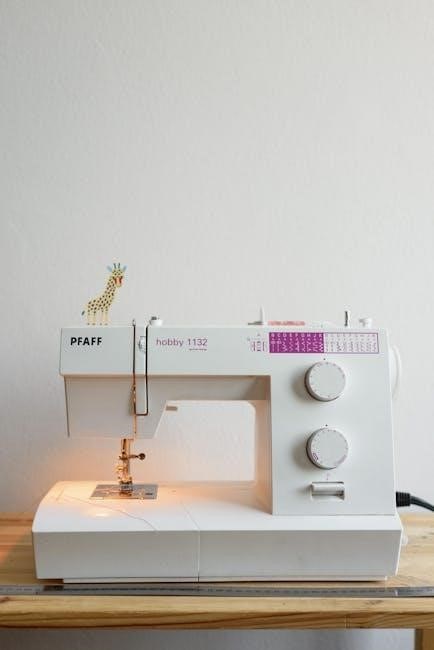
Major Parts of a Sewing Machine
A sewing machine consists of upper and lower parts. The upper parts include the spool pin, thread guide, tension disc, and take-up lever. The lower parts feature the needle bar, bobbin case, presser foot, and feed dogs, all working together to ensure smooth fabric movement and precise stitching.
2.1 Upper Parts of the Sewing Machine
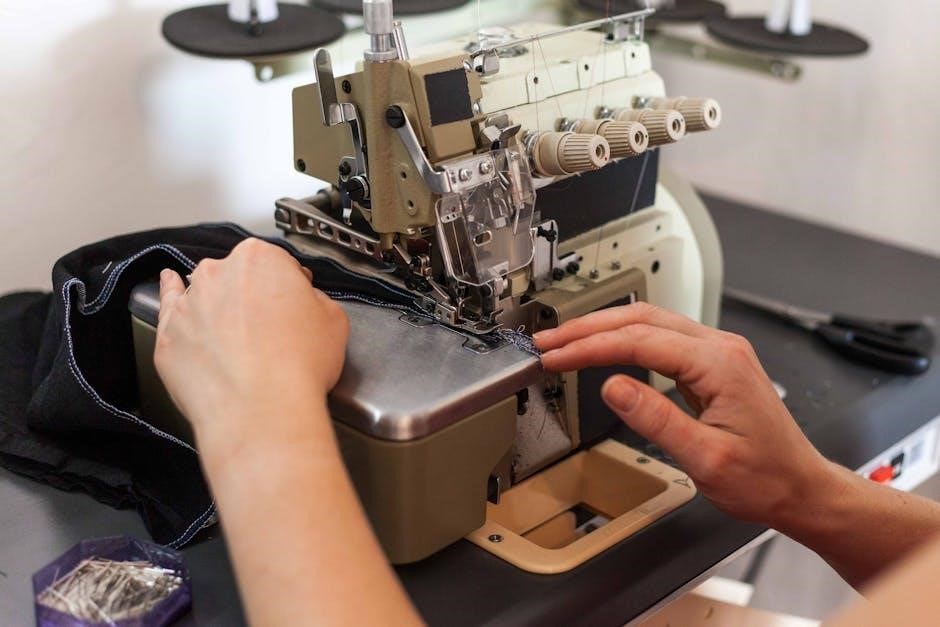
The upper parts of a sewing machine include essential components like the spool pin, thread guide, tension disc, and take-up lever. The spool pin holds the thread reel, while the thread guide directs the thread through the machine. The tension disc regulates thread tightness, ensuring even stitches. The take-up lever adjusts thread tension as fabric moves. These parts work together to manage thread flow and maintain consistent stitching. Additionally, the stitch width and length controls are typically located on the upper section, allowing users to customize their sewing settings. Understanding these upper parts is crucial for proper machine operation and troubleshooting common issues like uneven tension or thread breakage.
2.2 Lower Parts of the Sewing Machine
The lower parts of a sewing machine include the bobbin case, feed dogs, and presser foot. The bobbin case holds the bobbin, which supplies the bottom thread for stitching. The feed dogs are metal teeth that move fabric forward, ensuring even stitching. The presser foot, often detachable, presses fabric down for smooth sewing. These components work together to facilitate fabric movement and thread delivery. The shuttle hook, located in the lower section, interacts with the needle to form stitches. Understanding these lower parts is vital for maintaining proper fabric flow and achieving consistent stitch quality in various sewing projects.

Detailed Functions of Key Sewing Machine Parts
The needle bar moves up and down, piercing fabric to create stitches. The bobbin case holds the bottom thread, while the presser foot secures fabric in place. The feed dogs move fabric forward, ensuring even stitching. These components work together to form consistent stitches, essential for sewing efficiency and precision.
3.1 Spool Pin and Thread Guide
The spool pin holds the thread spool securely on the machine, ensuring thread is fed smoothly. The thread guide directs the thread from the spool through the machine, maintaining proper tension and alignment. Together, these parts prevent tangling and ensure consistent stitching. Proper use of the spool pin and thread guide is crucial for maintaining thread flow and preventing issues like bunching or uneven stitches. Regularly checking these components ensures smooth operation and high-quality sewing results.
3.2 Tension Disc and Take-Up Lever
The tension disc applies even pressure on the thread, ensuring proper tension as it flows through the machine. The take-up lever regulates thread tension dynamically, adjusting as fabric moves. Together, these parts maintain consistent stitching and prevent issues like loose threads or puckering. Correct adjustment is crucial for balanced stitching. If tension is too tight, it can cause thread breakage, while too loose may result in uneven stitches. Understanding how to use the tension disc and take-up lever effectively enhances sewing precision and overall machine performance, making them indispensable for achieving professional-quality results in various sewing projects.
3.3 Needle Bar and Bobbin Case
The needle bar holds and moves the sewing machine needle up and down to create stitches. Its precise movement is synchronized with the bobbin case, which houses the bobbin containing the bottom thread. Together, they form the stitch loop essential for sewing. The needle bar’s alignment and timing with the bobbin case are critical for consistent stitching. Improper alignment can cause thread issues or machine jams. The bobbin case also regulates thread flow from the bobbin, ensuring smooth operation. Proper maintenance, like cleaning the bobbin case and ensuring the needle bar is free from debris, is vital for optimal performance and stitch quality.
3.4 Presser Foot and Feed Dogs
The presser foot is a detachable metal piece that holds fabric firmly in place during sewing, preventing slippage. It works in collaboration with the feed dogs, which are tooth-like mechanisms that move the fabric forward or backward. The feed dogs synchronize with the needle’s up-and-down motion to ensure even stitching. Adjusting the presser foot pressure or feed dog speed allows for precise control over fabric movement. Different presser foot types, such as zigzag or walking feet, cater to specific sewing tasks. Proper alignment and maintenance of these parts are crucial for smooth operation and consistent stitch quality. They are essential for handling various fabrics and achieving professional results.
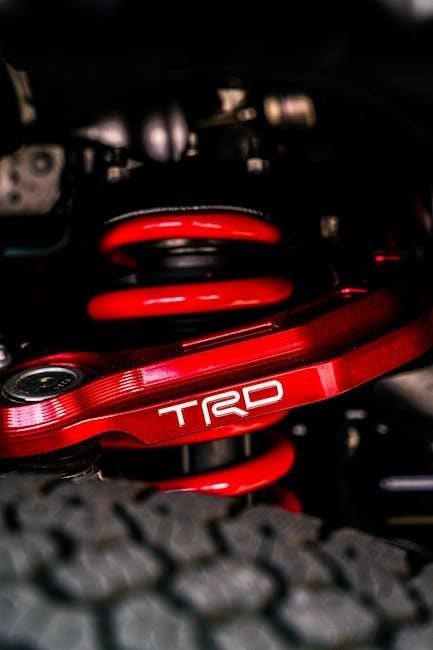
Operational Components of a Sewing Machine
Operational components like the hand wheel, balance wheel, and stitch controls enable precise fabric movement and stitching. These parts ensure smooth operation and customizable sewing experiences.
4.1 Hand Wheel and Balance Wheel
The hand wheel and balance wheel are crucial operational components of a sewing machine. The hand wheel, located on the right side, manually controls the needle’s up-and-down movement, allowing precise fabric positioning. It is particularly useful for sewing thick fabrics or when precise stitch placement is needed. The balance wheel, often integrated with the hand wheel, regulates the machine’s timing and ensures smooth operation. Proper use of these components helps maintain stitch consistency and prevents fabric bunching. Regular maintenance, such as lubrication, ensures their longevity and optimal performance. Understanding their functions enhances overall sewing efficiency and accuracy.
4.2 Stitch Length and Width Controls
Stitch length and width controls are essential for customizing stitches on a sewing machine. The stitch length dial adjusts the distance between stitches, determining how tight or loose the stitching appears. A shorter length is ideal for delicate fabrics, while a longer length suits thicker materials. The stitch width control, often a separate dial or button, regulates the width of zigzag stitches, allowing for straight lines or decorative patterns. These controls enable precise adjustments for various sewing tasks, from garment construction to home decor. Proper use ensures professional-looking results, making them indispensable for both beginners and experienced sewers. Always test settings on scrap fabric before sewing your final project.
4.3 Reverse Stitch Lever and Speed Control
The reverse stitch lever allows sewing in reverse, securing stitches at the start and end of seams. This feature is crucial for preventing fraying and ensuring durability. The speed control enables adjustment of the machine’s sewing speed, catering to different fabric types and user comfort. Slower speeds are ideal for delicate materials or intricate patterns, while faster speeds suit thicker fabrics and straight stitches. These controls enhance precision and versatility, making them indispensable for both beginners and experienced sewers. Proper use of the reverse stitch lever and speed control ensures professional-quality results and adaptability to various sewing projects.
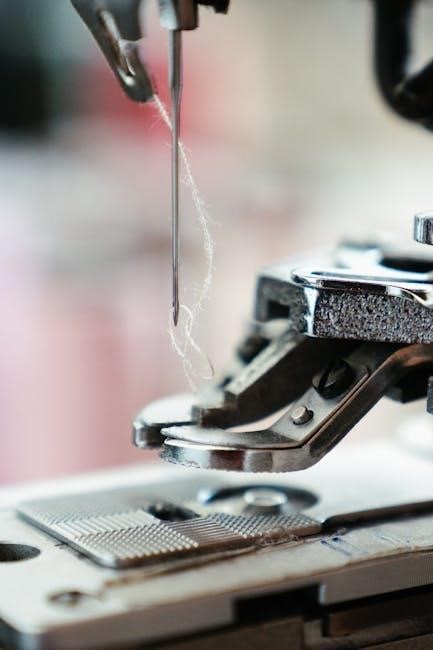
Maintenance and Care of Sewing Machine Parts
Regular lubrication of moving parts ensures smooth operation. Clean the bobbin and shuttle area to prevent thread jams. Follow a maintenance schedule to extend machine life and performance.
5.1 Lubrication of Moving Parts
Lubricating moving parts of your sewing machine is crucial for smooth operation and longevity. Use high-quality sewing machine oil to lubricate components like the needle bar and take-up lever. Apply a few drops to the specified areas, as indicated in your machine’s manual. Regular lubrication reduces friction, preventing wear and tear. Avoid over-lubrication, as excess oil can attract dust and cause residue buildup. Proper lubrication ensures consistent stitch quality and prevents mechanical issues. Always use the correct type of oil to maintain your machine’s performance and extend its lifespan. Regular maintenance, including lubrication, is essential for optimal sewing results.
5.2 Cleaning the Bobbin and Shuttle
Cleaning the bobbin and shuttle is essential for maintaining smooth stitching and preventing thread jams. Use a soft brush or cloth to gently remove lint and debris from these parts. Avoid harsh chemicals, as they can damage the machine. Regularly inspect and clean the bobbin case and shuttle to ensure proper thread flow. After cleaning, allow the parts to air dry before reinserting them. Proper maintenance of these components ensures consistent stitch quality and reduces the risk of mechanical issues. By keeping the bobbin and shuttle clean, you extend the life of your sewing machine and enhance its performance;
5.3 Regular Maintenance Schedule
Regular maintenance is crucial for the optimal performance of your sewing machine. Create a schedule to ensure all parts function smoothly and extend the machine’s lifespan. Daily tasks include cleaning lint from the bobbin area and checking for loose parts. Weekly, lubricate moving components like the needle bar and hook with a few drops of sewing machine oil. Monthly, inspect the bobbin case and feed dogs for proper alignment and cleanliness. Every six months, have a professional service the machine to address internal mechanisms. Adhering to this schedule prevents mechanical issues, ensures consistent stitching, and maintains the machine’s efficiency. Regular care also reduces the risk of unexpected breakdowns, keeping your sewing machine in top condition for years;
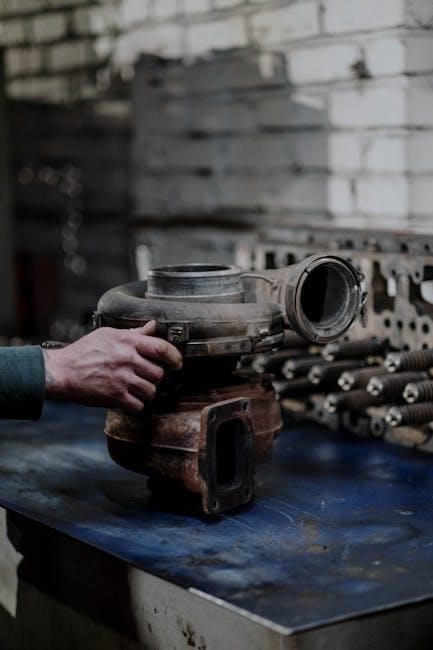
Accessories for Sewing Machines
Discover essential sewing machine accessories like presser feet, needles, and attachments. These tools enhance your sewing experience, offering specialized functions for various fabrics and techniques. Explore their uses and benefits in detail.
6.1 Presser Foot Varieties and Uses
Presser feet are essential sewing machine accessories that help guide fabric smoothly. The standard presser foot is ideal for straight stitching, while the zipper foot is perfect for sewing zippers and narrow seams. A walking foot is designed for heavy fabrics like leather or multiple layers, ensuring even feeding; The edging foot is great for overlocking and finishing raw edges, and the blind hem foot is ideal for creating nearly invisible hems. Quilting feet are designed for precision stitching on large projects. Each foot serves a specific purpose, enhancing your sewing experience and ensuring professional results. Choose the right presser foot for your project to achieve optimal outcomes.
6.2 Sewing Machine Needles and Their Types
Sewing machine needles come in various types, each designed for specific fabrics and techniques. Universal needles are versatile for general sewing, suitable for most fabrics. Sharp needles are ideal for piercing dense materials like leather or heavy canvas. Blunt needles, such as denim or heavy-duty needles, are designed for thick fabrics to prevent breaking. Stretch needles are perfect for knits and elastic materials, ensuring smooth stitches without fabric distortion. Embroidery needles feature a large eye for decorative threads, while quilting needles are designed for thick batting and layered fabrics. Choosing the right needle type ensures better stitch quality and prevents fabric damage.
6.3 Additional Attachments for Specialized Sewing
Additional attachments enhance sewing machine functionality for specialized tasks. A walking foot is ideal for thick fabrics or multiple layers, preventing drag. Rufflers create gathers for decorative effects, while cording feet handle thick threads. Edge joiners bind seams neatly, and pintuck feet craft decorative folds. These attachments expand creative possibilities, allowing for intricate stitching and professional finishes. Whether quilting, embroidering, or working with heavy materials, specialized attachments optimize results, ensuring precision and efficiency in every stitch. They empower sewers to tackle complex projects with confidence, transforming their machine into a versatile tool for diverse sewing needs.
Troubleshooting Common Sewing Machine Issues
Identify and resolve common issues like thread tension problems, bobbin jams, and machine noise. Adjust tension discs, clean the bobbin area, and ensure proper hook alignment for smooth operation. Lubricate moving parts and tighten loose components to minimize noise and vibration, ensuring optimal performance.
7.1 Identifying and Solving Thread Tension Problems
Thread tension issues are common in sewing machines, often causing uneven stitches or fabric puckering. Check the tension discs and ensure they are properly adjusted. If the thread is too tight, loosen the tension discs; if too loose, tighten them. Use the take-up lever to fine-tune tension while sewing. Ensure the correct thread type is used for the fabric. Regularly clean the tension discs and thread guides to prevent dirt buildup. Test stitches on scrap fabric before sewing to ensure even tension. Proper thread tension is key to achieving professional-looking results and preventing machine damage.
7.2 Fixing Issues with the Bobbin and Hook
Issues with the bobbin and hook can disrupt stitching and cause machine jams. If the bobbin is misaligned or improperly seated, remove it and ensure it fits correctly in the bobbin case; Check for thread tangles or knots around the hook. Clean the hook area regularly to remove debris. If the hook timing is off, consult the manual or seek professional adjustment. Always use the correct type of bobbin for your machine. Wind thread evenly on the bobbin to prevent uneven stitching. Properly threading the machine and maintaining the bobbin and hook ensures smooth operation and consistent stitch quality.
7.3 Addressing Machine Noise and Vibration
Excessive noise and vibration in a sewing machine can hinder operation and lead to mechanical issues. Begin by checking the balance wheel to ensure it’s moving smoothly and not obstructed. Proper lubrication of moving parts, such as the needle bar and hook, is crucial to reduce friction and noise. Ensure the bobbin case is securely fitted and aligned correctly. If vibration persists, verify that the machine is placed on a stable surface. Regular maintenance, including cleaning and oiling, helps maintain optimal performance and minimizes disruptive noise. Addressing these issues promptly prevents further complications and extends the machine’s lifespan.
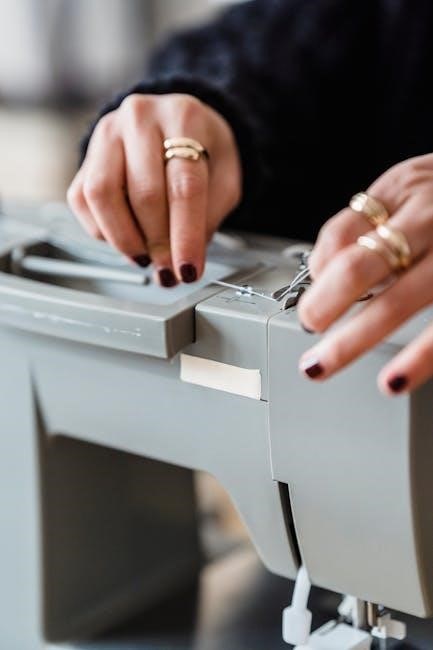
Guide to Choosing the Right Sewing Machine Parts
Selecting the right sewing machine parts is crucial for optimal performance. Ensure compatibility with your machine’s make and model for seamless functionality and durability in various sewing tasks.
Understand the specific requirements for needles, threads, and presser feet based on fabric types. Always refer to your machine’s manual for guidance on choosing appropriate accessories and components.
Investing in high-quality, compatible parts enhances stitching quality and extends machine lifespan. Proper selection ensures smooth operation and addresses specialized sewing needs effectively.
8.1 Selecting the Correct Needle Type
Selecting the correct needle type is vital for achieving professional results in sewing. Different fabrics require specific needle types to ensure smooth stitching and prevent damage. Sharp needles are ideal for woven fabrics like cotton and linen, while blunt needles, such as ballpoint or tapestry needles, are better for knits or delicate materials. Heavy-duty needles, like denim or leather needles, are designed for thick fabrics. Understanding the needle types and their purposes helps in choosing the right one for your project. Regularly changing needles ensures optimal performance and prevents thread breakage or fabric damage. Always refer to your sewing machine manual for compatibility guidelines.
- Sharp needles for woven fabrics.
- Blunt needles for knits or delicate materials.
- Heavy-duty needles for thick fabrics like denim or leather.
- Embroidery needles for decorative stitching.
Replace needles when they show signs of wear or after every major project for consistent results.
8.2 Understanding Thread Compatibility
Understanding thread compatibility is crucial for seamless sewing. The type of thread used must match the fabric and project requirements to ensure durability and a professional finish. Natural fibers like cotton or silk work best with cotton or polyester threads, while synthetic fabrics require polyester or nylon threads. Heavy-duty threads are ideal for thick materials like denim or canvas. Always consider thread weight and ply for the right balance of strength and flexibility. Color matching is also important for a cohesive look. Consult your sewing machine manual for thread recommendations tailored to your specific model and fabric type. Proper thread selection enhances stitch quality and prevents breakage during sewing.
- Natural fibers: cotton, silk;
- Synthetic fabrics: polyester, nylon.
- Heavy-duty materials: denim, canvas.
Regularly check thread quality and store it properly to maintain performance.
8.3 Choosing the Right Presser Foot for the Job
Choosing the right presser foot is essential for achieving professional results in sewing. Different presser feet are designed for specific tasks, such as zippers, buttonholes, or heavy fabrics. The all-purpose foot is ideal for general sewing, while the zipper foot is perfect for precise zipper installation. A walking foot is recommended for quilting or thick layers, ensuring smooth fabric movement. Always match the presser foot to your project’s requirements for better control and accuracy. Consult your sewing machine manual to explore the variety of presser feet available and their specialized functions. Proper selection enhances stitching quality and makes sewing more efficient.
- All-purpose foot: general sewing.
- Zipper foot: zippers and piping.
- Walking foot: quilting and heavy fabrics.
Using the correct presser foot ensures optimal performance and prevents fabric slippage.
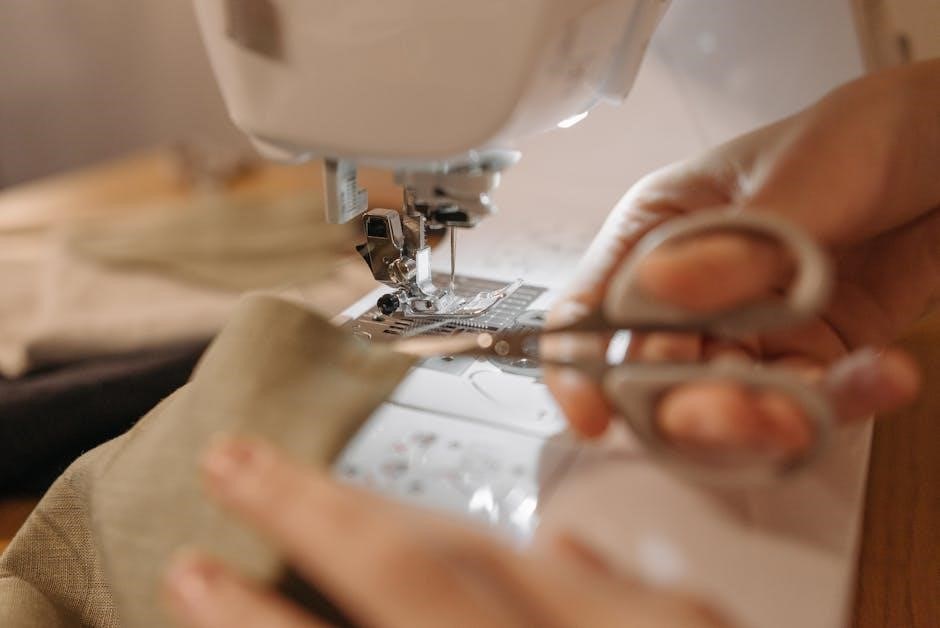
Advanced Features of Modern Sewing Machines
Modern sewing machines offer advanced features like computerized stitch patterns, automatic thread cutters, and programmable memory functions, enhancing efficiency and precision for both casual and professional sewers.
9.1 Computerized Sewing Machines and Their Functions
Computerized sewing machines are equipped with advanced technology, offering programmable stitch patterns, memory functions, and touchscreen controls. These machines allow users to customize stitches, save designs, and access pre-loaded patterns, making intricate sewing projects easier. They often feature embroidery capabilities, automatic thread cutters, and adaptive tension control. Some models include Wi-Fi connectivity for downloading new stitch designs. Additionally, computerized machines provide precise speed control and silent operation, ideal for professional-grade sewing. They are versatile, catering to both casual hobbyists and experienced sewists, enabling the creation of complex garments and home decor with ease and efficiency. These features enhance creativity and productivity, making them a valuable investment for sewers.
9.2 Automatic Thread Cutters and Their Benefits
Automatic thread cutters are a convenient feature in modern sewing machines, eliminating the need for manual thread trimming. This innovation saves time and reduces waste, ensuring clean starts and finishes. By automatically cutting the thread at the end of a seam, it prevents loose ends and maintains fabric integrity. This feature is particularly beneficial for quilters and those working on large projects, as it streamlines the sewing process. Automatic thread cutters also enhance precision, reducing the risk of uneven stitches. They are a valuable addition to computerized machines, offering efficiency and consistency, making sewing more enjoyable and professional-grade results achievable with ease.
9.3 Programmable Stitch Patterns and Memory Functions
Modern sewing machines often feature programmable stitch patterns and memory functions, allowing users to customize and save their favorite stitches. These advanced features enable the creation of intricate designs and consistent results. Programmable patterns can be tailored to specific fabrics or projects, while memory functions store these settings for quick access. This capability is especially useful for complex embroidery or repetitive tasks, ensuring efficiency and precision. By saving preferred stitches, sewers can maintain uniformity across large-scale projects. These functions enhance creativity and productivity, making them indispensable for both hobbyists and professionals seeking to expand their sewing capabilities and achieve flawless outcomes every time.
Mastery of sewing machine parts and functions enhances sewing skills and machine longevity. Regular maintenance and understanding components ensure optimal performance, leading to successful sewing projects and creations.
10.1 Recap of Key Sewing Machine Parts and Functions
The essential sewing machine parts include the spool pin, thread guide, tension disc, take-up lever, bobbin, and presser foot. These components work together to manage thread, regulate tension, and facilitate stitch formation. The needle bar and feed dogs ensure proper fabric movement, while the hand wheel controls the needle’s up-down motion. Understanding these parts is crucial for troubleshooting and maintaining the machine. Regular lubrication of moving parts, such as the needle bar and hook, ensures smooth operation. Familiarity with these key elements enhances sewing efficiency and helps in achieving professional-quality results. Proper care and maintenance of these parts extend the machine’s lifespan and performance quality.
10.2 Final Tips for Effective Sewing Machine Usage
To maximize your sewing machine’s performance, always refer to the manual for model-specific guidance. Regularly clean and lubricate moving parts to ensure smooth operation. Use the correct needle type and thread for your fabric to prevent breakage and ensure even stitching. Properly thread the machine, following the thread guide, and maintain consistent tension. Keep extra bobbins wound and ready to save time. Familiarize yourself with stitch length and width controls for precise results. Store your machine in a dry, clean environment to prevent rust or damage. Practice on scrap fabric before working on projects to test settings and ensure accuracy. Happy sewing!